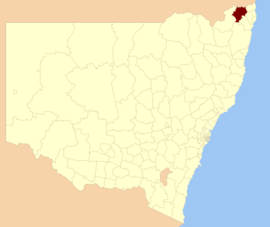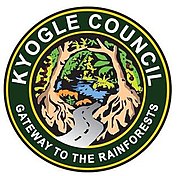Kyogle Council
| Kyogle Council New South Wales | |||||||||||||||
|---|---|---|---|---|---|---|---|---|---|---|---|---|---|---|---|
 Location in New South Wales | |||||||||||||||
| Coordinates | 28°37′30″S 153°00′43″E / 28.625°S 153.012°E | ||||||||||||||
| Population | 9,537 (2015 est)[1] | ||||||||||||||
| • Density | 2.6573/km2 (6.8823/sq mi) | ||||||||||||||
| Area | 3,589 km2 (1,385.7 sq mi)[2] | ||||||||||||||
| Mayor | Danielle Mulholland, (Independent) | ||||||||||||||
| Council seat | Kyogle | ||||||||||||||
| Region | Northern Rivers | ||||||||||||||
| State electorate(s) | Lismore [3] | ||||||||||||||
| Federal division(s) | Page[4] | ||||||||||||||
 | |||||||||||||||
| Website | Kyogle Council | ||||||||||||||
| |||||||||||||||
Kyogle Council is a local government area in the Northern Rivers region of New South Wales, Australia.
The council services an area of 3,589 square kilometres (1,386 sq mi) and is located adjacent to the Summerland Way and the North Coast railway line, within two hours drive from Brisbane and one hour from the Queensland Gold Coast and the NSW coastal communities of Byron Bay, Ballina and Tweed Heads. Kyogle Council comprises a large and diverse region with natural attributes, including the Border Ranges National Park and other world heritage listed areas, and cultural features.[5]
The Mayor of Kyogle Council is Clr. Danielle Mulholland, an independent politician.[6]
Towns and localities
- Kyogle
- Bonalbo
- Tabulam
- Woodenbong
- Afterlee
- Barkers Vale
- Bottle Creek
- Capeen
- Cawongla
- Collins Creek
- Cougal
- Ettrick
- Findon Creek
- Green Pigeon
- Grevillia
- Homeleigh
- Horseshoe Creek
- Iron Pot Creek
- Loadstone
- Lynchs Creek
- Mallanganee
- Mount Lion
- Mummulgum
- Old Bonalbo
- Rukenvale
- Terrace Creek
- The Risk
- Theresa Creek
- Tooloom
- Toonumbar
- Tunglebung
- Upper Horseshoe Creek
- Wadeville
- Wiangaree
- Woolners Arm
Demographics
At the 2011 census, there were 9,228 people in the Kyogle local government area, of these 50.3 per cent were male and 49.7 per cent were female. Aboriginal and Torres Strait Islander people made up 5.3 per cent of the population, which was significantly higher than the national and state averages of 2.5 per cent. The median age of people in the Kyogle Council area was 45 years, which was significantly higher than the national median of 37 years. Children aged 0 – 14 years made up 19.1 per cent of the population and people aged 65 years and over made up 17.3 per cent of the population. Of people in the area aged 15 years and over, 46.6 per cent were married and 15.1 per cent were either divorced or separated.[7]
Population growth in the Kyogle Council area between the 2001 census and the 2006 census was 1.06 per cent; and in the subsequent five years to the 2011 census, the population declined 0.3 per cent. When compared with total population growth of Australia for the same periods, being 5.78 per cent and 8.32 per cent respectively, population growth in the Kyogle local government area was significantly lower than the national average.[8][9] The median weekly income for residents within the Kyogle Council area was significantly lower than the national average.[7]
At the 2011 census, the proportion of residents in the Kyogle local government area who stated their ancestry as Australian or Anglo-Saxon exceeded 85 per cent of all residents (national average was 65.2 per cent). In excess of 23 per cent of all residents in the Kyogle Council at the 2011 census nominated no religious affiliation, compared to the national average of 22.3 per cent. Meanwhile, affiliation with Christianity was 55 per cent, which was slightly higher than the national average of 50.2 per cent. As at the census date, compared to the national average, households in the Kyogle local government area had a significantly lower than average proportion (3.5 per cent) where two or more languages are spoken (national average was 20.4 per cent); and a significantly higher proportion (92.9 per cent) where English only was spoken at home (national average was 76.8 per cent).[7]
| Selected historical census data for the Kyogle Council local government area | |||||
|---|---|---|---|---|---|
| Census year | 2001[8] | 2006[9] | 2011[7] | ||
| Population | Estimated residents on Census night | 9,159 | 9,256 | 9,228 | |
| LGA rank in terms of size within New South Wales | 92 | ||||
| % of New South Wales population | 0.13% | ||||
| % of Australian population | 0.05% | ||||
| Cultural and language diversity | |||||
| Ancestry, top responses |
Australian | 32.3% | |||
| English | 31.6% | ||||
| Irish | 10.2% | ||||
| Scottish | 7.7% | ||||
| German | 3.4% | ||||
| Language, top responses (other than English) |
German | 0.6% | |||
| Italian | 0.2% | ||||
| Swedish | n/c | ||||
| French | 0.1% | ||||
| Telugu | n/c | n/c | |||
| Religious affiliation | |||||
| Religious affiliation, top responses |
No Religion | 15.1% | |||
| Anglican | 23.9% | ||||
| Catholic | 21.0% | ||||
| Uniting Church | 11.0% | ||||
| Presbyterian and Reformed | 7.0% | ||||
| Median weekly incomes | |||||
| Personal income | Median weekly personal income | A$305 | A$376 | ||
| % of Australian median income | 65.5% | ||||
| Family income | Median weekly family income | A$705 | A$883 | ||
| % of Australian median income | 60.2% | ||||
| Household income | Median weekly household income | A$599 | A$714 | ||
| % of Australian median income | 58.3% | ||||
Council
Current composition and election method
Kyogle Council is composed of nine Councillors elected proportionally as three separate wards, each electing three Councillors. The Councillors are elected for a fixed four-year term of office. The Mayor is elected by the Councillors at the first meeting of the Council. The most recent election was held on 10 September 2016, and the makeup of the Council is as follows:[10][11][12]
| Party | Councillors | |
|---|---|---|
| Unaligned and Independents | 9 | |
| Total | 9 | |
The current Council, elected in 2012, in order of election by ward, is:
| Ward | Councillor | Party | Notes | |
|---|---|---|---|---|
| A Ward[10] | Kylie Thomas | Independent | ||
| Hayden Doolan | Independent | |||
| Janet Wilson | Independent | |||
| B Ward[11] | John Burley | Unaligned | Deputy Mayor[13] | |
| Robert Dwyer | Independent | |||
| Maggie May | Independent | |||
| C Ward[12] | Danielle Mulholland | Independent | Mayor[13] | |
| Lindsay Passfield | Independent | |||
| Earle Grundy | Independent | |||
References
- ^ "3218.0 – Regional Population Growth, Australia, 2014–15". Australian Bureau of Statistics. Retrieved 29 September 2016.
- ^ "Kyogle Council". Department of Local Government. Retrieved 19 November 2006.
- ^ "Lismore Electoral District". New South Wales Electoral Commission. Retrieved 19 November 2006.
- ^ "Richmond". Australian Electoral Commission. Retrieved 19 November 2006.
- ^ "Annual Report 2014/2015" (PDF). Kyogle Council. 9 November 2015. p. 4. Retrieved 28 May 2016.
- ^ "Councillor Danielle Mulholland". Meetings, Mayor and Councillors. Kyogle Council. September 2014. Retrieved 28 May 2016.
- ^ a b c d Australian Bureau of Statistics (31 October 2012). "Kyogle". 2011 Census QuickStats. Retrieved 28 May 2016.
- ^ a b Australian Bureau of Statistics (9 March 2006). "Kyogle (A)". 2001 Census QuickStats. Retrieved 22 May 2016.
- ^ a b Australian Bureau of Statistics (25 October 2007). "Community Profile Series: Kyogle (A) (Local Government Area)". 2006 Census of Population and Housing. Retrieved 27 October 2010.
- ^ a b "Kyogle Council - A Ward: Summary of First Preference and Group Votes for each Candidate". Local Government Election 2016. New South Wales Electoral Commission. 17 September 2016. Retrieved 20 October 2016.
- ^ a b "Kyogle Council - B Ward: Summary of First Preference and Group Votes for each Candidate". Local Government Election 2016. New South Wales Electoral Commission. 17 September 2012. Retrieved 20 October 2016.
- ^ a b "Kyogle Council - C Ward: Summary of First Preference and Group Votes for each Candidate". Local Government Election 2016. New South Wales Electoral Commission. 17 September 2016. Retrieved 20 October 2016.
- ^ a b Mclauchlan, Cathryn. "New mayor for Kyogle revealed after big win at council meeting". Sunshine Coast Daily. Retrieved 20 October 2016.
External links
![]() Media related to Kyogle Council at Wikimedia Commons
Media related to Kyogle Council at Wikimedia Commons
